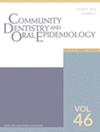An important part of Norwegian welfare policy is to provide subsidized orthodontic treatment for children and adolescents. The objective of this policy is that dental services should be allocated according to children's need for treatment, and not according to parents' ability to pay. The probability of receiving orthodontic treatment independent of parent's household income was examined.
The study population encompassed children and adolescents aged 10–18 years in 2019 (n = 354 439). Information about whether they had started orthodontic treatment was obtained from the Norwegian Health Economics Administration. The key independent variable was net equalized household income. Inequalities were measured using concentration indices, which were estimated according to the severity of the malocclusion (very great need, great need, obvious need and no need). Two indices were used to measure relative inequality: the unstandardized concentration index and the partial concentration index. Absolute inequality was measured using the corrected concentration index. Relevant control variables were included in some of the analyses.
The unstandardized indices were in the range 0.04 (very great need) to 0.05 (obvious need). For all three groups of severity, the 95% confidence intervals overlapped. The values of the partial indices were significantly lower than the values of the unstandardized indices. The partial indices were in the range 0.008 (very great need) to 0.03 (obvious need). The 95% confidence intervals for the partial indices did not overlap with the 95% confidence intervals of the unstandardized indices. For all three groups of severity, the indices that measured absolute inequality were close to zero.
It is possible to achieve the egalitarian aim of equality in service provision by subsidizing orthodontic treatment. This is possible within a system where the cost of orthodontic treatment is reimbursed according to the criteria of need. These criteria function in such a way that patients with the greatest need for orthodontic treatment are given the highest priority.



